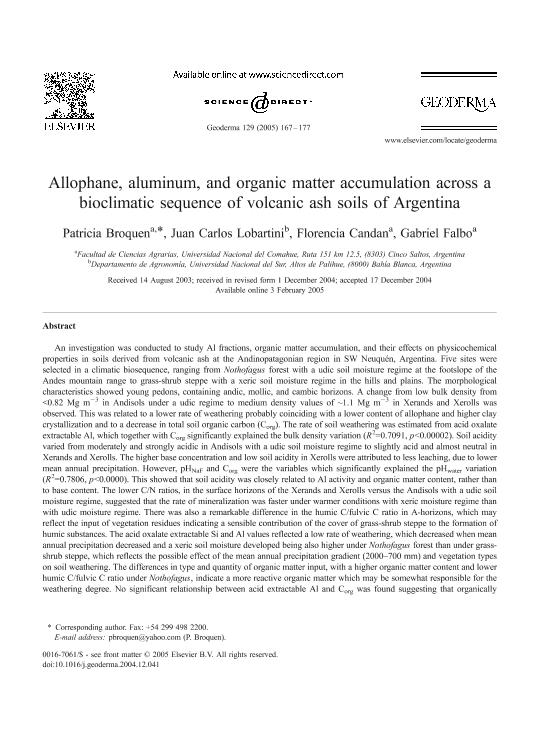Artículo
Allophane, aluminum, and organic matter accumulation across a bioclimatic sequence of volcanic ash soils of Argentina
Fecha de publicación:
12/2005
Editorial:
Elsevier Science
Revista:
Geoderma
ISSN:
0016-7061
Idioma:
Inglés
Tipo de recurso:
Artículo publicado
Clasificación temática:
Resumen
An investigation was conducted to study Al fractions, organic matter accumulation, and their effects on physicochemical properties in soils derived from volcanic ash at the Andinopatagonian region in SW Neuquén, Argentina. Five sites were selected in a climatic biosequence, ranging from Nothofagus forest with a udic soil moisture regime at the footslope of the Andes mountain range to grass-shrub steppe with a xeric soil moisture regime in the hills and plains. The morphological characteristics showed young pedons, containing andic, mollic, and cambic horizons. A change from low bulk density from <0.82 Mg m-3 in Andisols under a udic regime to medium density values of ∼1.1 Mg m-3 in Xerands and Xerolls was observed. This was related to a lower rate of weathering probably coinciding with a lower content of allophane and higher clay crystallization and to a decrease in total soil organic carbon (Corg). The rate of soil weathering was estimated from acid oxalate extractable Al, which together with Corg significantly explained the bulk density variation (R 2=0.7091, p<0.00002). Soil acidity varied from moderately and strongly acidic in Andisols with a udic soil moisture regime to slightly acid and almost neutral in Xerands and Xerolls. The higher base concentration and low soil acidity in Xerolls were attributed to less leaching, due to lower mean annual precipitation. However, pHNaF and Corg were the variables which significantly explained the pHwater variation (R 2=0.7806, p<0.0000). This showed that soil acidity was closely related to Al activity and organic matter content, rather than to base content. The lower C/N ratios, in the surface horizons of the Xerands and Xerolls versus the Andisols with a udic soil moisture regime, suggested that the rate of mineralization was faster under warmer conditions with xeric moisture regime than with udic moisture regime. There was also a remarkable difference in the humic C/fulvic C ratio in A-horizons, which may reflect the input of vegetation residues indicating a sensible contribution of the cover of grass-shrub steppe to the formation of humic substances. The acid oxalate extractable Si and Al values reflected a low rate of weathering, which decreased when mean annual precipitation decreased and a xeric soil moisture developed being also higher under Nothofagus forest than under grass-shrub steppe, which reflects the possible effect of the mean annual precipitation gradient (2000-700 mm) and vegetation types on soil weathering. The differences in type and quantity of organic matter input, with a higher organic matter content and lower humic C/fulvic C ratio under Nothofagus, indicate a more reactive organic matter which may be somewhat responsible for the weathering degree. No significant relationship between acid extractable Al and Corg was found suggesting that organically bound Al is not dominant. The detection of higher allophane estimations in soils with the highest Corg levels, may indicate that the anti-allophanic hypothesis probably does not apply to these soils.
Palabras clave:
ALUMINUM
,
ANDINOPATAGONIA
,
ORGANIC MATTER
,
VOLCANIC ASH SOILS
Archivos asociados
Licencia
Identificadores
Colecciones
Articulos(CCT - BAHIA BLANCA)
Articulos de CTRO.CIENTIFICO TECNOL.CONICET - BAHIA BLANCA
Articulos de CTRO.CIENTIFICO TECNOL.CONICET - BAHIA BLANCA
Citación
Broquen, Patricia Cecilia; Lobartini, Juan Carlos; Candan, Florencia; Falbo, Gabriel; Allophane, aluminum, and organic matter accumulation across a bioclimatic sequence of volcanic ash soils of Argentina; Elsevier Science; Geoderma; 129; 3-4; 12-2005; 167-177
Compartir
Altmétricas




